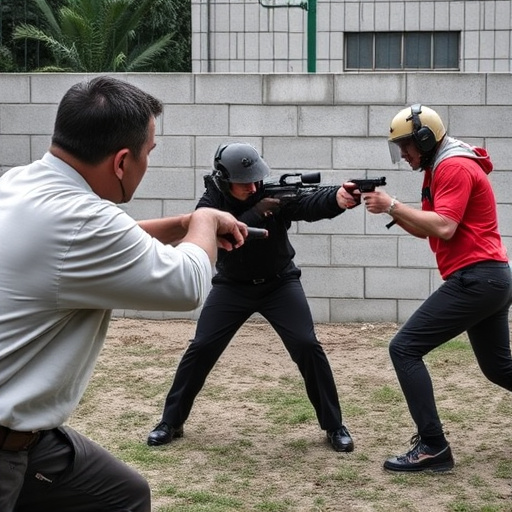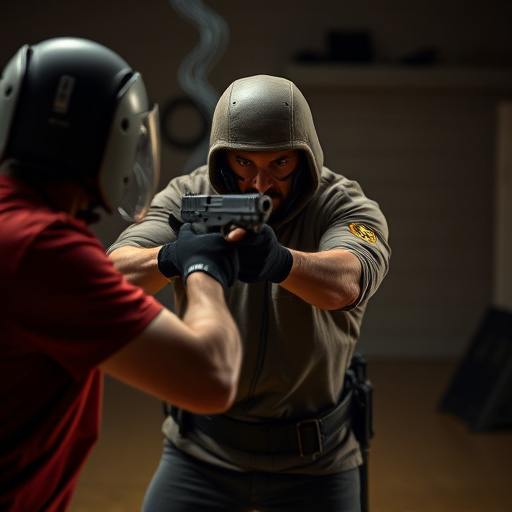For beginners considering stun guns as a self-defense option, understanding amperage (electric current strength) is crucial. Higher amperages deliver stronger shocks but increase injury risk, while lower settings are safer for less severe situations. Stun guns with safety features, including motion sensors and automatic shut-off functions, cater to beginners' needs. Adjusting amperage settings allows users to adapt their defense strategy while ensuring safe deployment, making these devices powerful tools when used responsibly. Choosing the right amperage level based on training and scenario is essential for effective and safe use of stun guns with safety features for beginners.
Electrical shock weapons, like stun guns, deliver a powerful jolt through controlled electric current. The effectiveness and safety of these devices hinge on amperage—the rate at which electricity flows. This article demystifies amperage, guiding stun gun novices through essential safety features and the role amperage plays in their impact. From understanding current flow to navigating device specifications, discover how to choose a stun gun with robust safety measures for confident use.
- Understanding Amperage: The Key to Electrical Shock Weapon Effectiveness
- Stun Guns for Beginners: Safety Features and Amperage Considerations
- How Amperage Influences the Safety and Impact of Stun Devices
Understanding Amperage: The Key to Electrical Shock Weapon Effectiveness

Understanding Amperage: The Key to Electrical Shock Weapon Effectiveness
When it comes to electrical shock weapons, like stun guns, understanding amperage is crucial for comprehending their effectiveness and safety features. Amperage, measured in amps, represents the rate at which electric charge flows through a circuit. In the context of stun devices, higher amperage means more powerful shocks, making them more effective in neutralizing targets quickly. However, it’s not just about power; it’s also about control. Stun guns with safety features for beginners often incorporate adjustable amperage settings, allowing users to manage shock intensity while minimizing risk of injury or accidental discharge.
This dual consideration—power and control—is key to ensuring the responsible use of such devices. Beginners should opt for models that offer precise control over amperage levels, enabling them to adapt to various situations and personal comfort levels. By understanding how amperage affects the shock’s impact, users can make informed decisions about when and how to deploy these powerful tools, prioritizing safety while reaping their intended benefits.
Stun Guns for Beginners: Safety Features and Amperage Considerations

Stun guns, designed to temporarily incapacitate individuals through electrical shock, are popular self-defense tools among beginners and seasoned users alike. For those new to stun guns, understanding safety features is paramount. Many modern stun guns incorporate advanced safety mechanisms like motion sensors and automatic shut-off functions to prevent accidental activation, ensuring the user’s safety and the device’s longevity.
When considering a stun gun for personal protection, amperage—the amount of electric current flowing through the body—is a critical factor. Higher amperage typically delivers a more powerful shock but can also increase the risk of side effects if not used correctly. Beginners should opt for stun guns with adjustable amperage settings to cater to various situations and comfort levels, allowing them to adapt their defense strategy while prioritizing safety.
How Amperage Influences the Safety and Impact of Stun Devices

Amperage, or the amount of electric current flowing through a circuit, plays a critical role in determining the safety and effectiveness of stun devices like stun guns. In stun weapons, higher amperage generally translates to a more intense shock, which can disable an assailant for a short period. However, this increased power also heightens the risk of injury or even cardiac arrest if not used properly.
For beginners considering stun guns with safety features, understanding amperage is key. Lower amperage settings are safer and suitable for less threatening situations, while higher amperages should be reserved for more severe self-defense scenarios where the user has received adequate training to minimize risks. Safe use involves targeting specific nerve centers while avoiding vital organs and blood vessels to ensure a neutralizing impact without causing permanent harm.
Understanding amperage is crucial for anyone considering stun guns as a personal defense tool. As this article has highlighted, the right amperage ensures not only effectiveness in neutralizing an assailant but also promotes user safety. For those new to stun guns, prioritizing devices with built-in safety features and specific amperage ratings is essential. By choosing stun guns with safety features designed for beginners, users can gain confidence while minimizing risks associated with high amperage shock.
